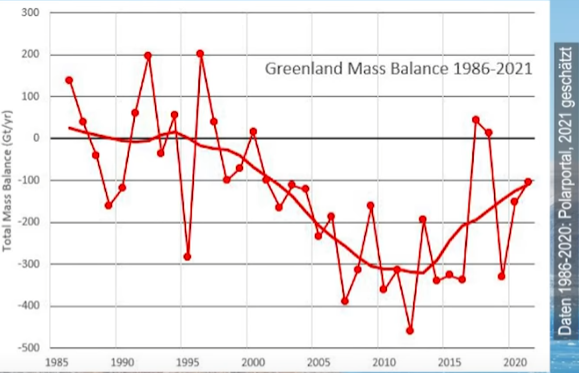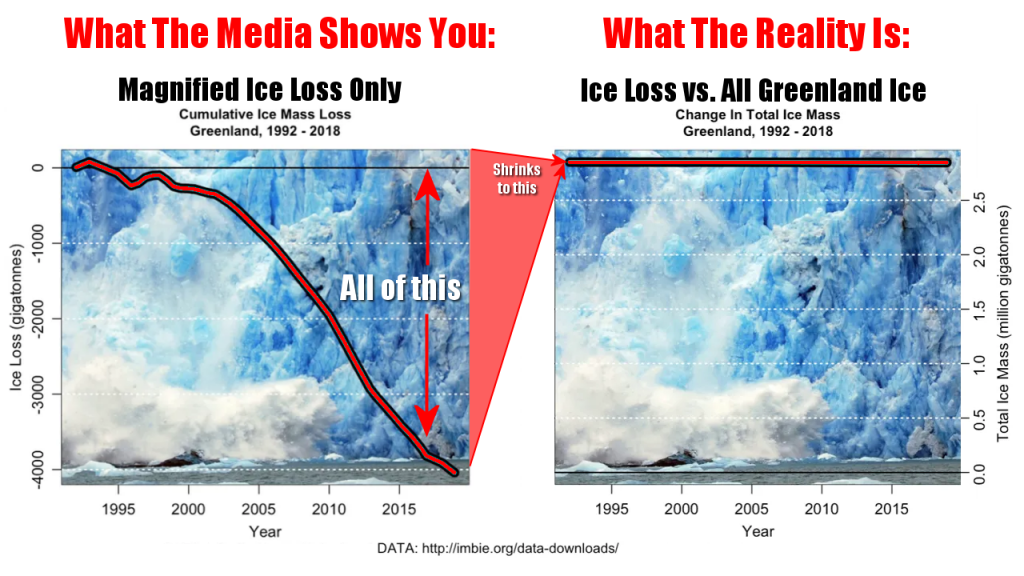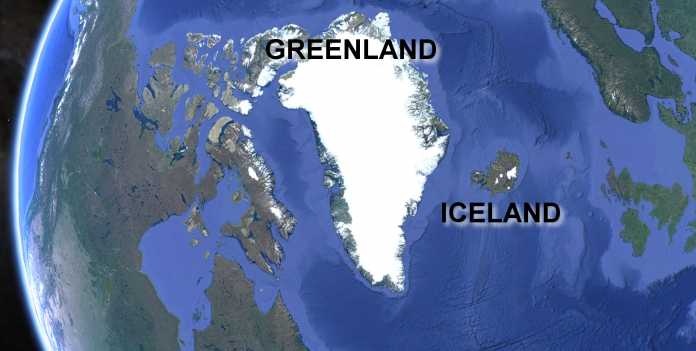A number of media outlets have sounded false alarms over the past week claiming headlines like “Greenland’s Ice Sheet Is Melting So Fast That It’s Creating a Flood Warning for the World” and “Ice on the edge of survival: Warming is changing the Arctic.”
Dozens of media stories stem from a new research article published in the Journal Nature Communications on November 1. One story, by USA Today says “3.5 trillion tons of Greenland’s ice sheet melted from 2011 to 2020, which would be enough to flood all of New York City in 14,700 feet of water.”
However, this ludicrous claim is obviously make-believe, since as of this writing, New York City is still a dry and thriving city.
The research claims Greenland’s ice melt was 21 % higher between 2011 and 2020 than over the preceding three decades, and from that we are supposed to be alarmed.
While the 21% number may very well be true, the media conclusions from the number aren’t.
First, nine years of data does not a climate trend make, and as the World Meteorological Organization states, a thirty year period is what defines any climate data set. Trying to draw conclusions about “climate change” with only nine years of data simply doesn’t work, and is not proper scientific practice.
Second, the researchers have omitted what has happened in the last few years in Greenland, which is indication of new growth in ice mass.
Currently, data illustrates that Greenland ice mass balance change is at levels last seen in 2000, as you can see in Figure 1 below.

Greenland ice mass change bottomed out in 2012, and has been seeing less and less loss since then. Each year since 2012 ice mass loss has been declining.
With an upswing in ice gain, the days of ice mass loss are behind us, at least for now. Based on the current data, 2021 is expected to come in at just under 100 gigatonnes of ice loss, which is insignificant compared to the entire amount of ice in Greenland – more on that below. Note that in 2017 and 2018, ice mass was actually added in Greenland. However, while the latest research can claim 21 % higher loss between 2011 and 2020, that doesn’t hold true over the entire dataset going back to 1986.
Thirdly, the amount of ice being lost is miniscule compared to the total ice mass of Greenland, which is estimated to be approximately 2.4 million gigatonnes. Let that number sink in, because it is a staggeringly large amount of ice. Numerically that is 2,400,000,000,000,000 tonnes or two quadrillion four hundred trillion tonnes.
Now compare that huge number to the loss of 300 gigatonnes of ice in 2012, shown in Figure 1. Total Greenland ice loss each year is a nearly undetectable five one-thousandths of one percent (0.005 percent) of the entire Greenland ice mass.
As pointed out at Climate at A Glance, Greenland Ice Melt, when all of the data is used to graph Greenland’s ice, the result is insignificant, as show in Figure 2.

In essence, the purported “catastrophic” loss of ice in Greenland doesn’t even register on the scale of the graph at the right. When recent ice loss is compared to the full Greenland ice sheet, the loss is so small that it is almost undetectable.
And finally, sea-level measurements contradict media claims that Greenland ice loss threatens flooding. NASA satellite instruments, with readings dating back to 1993, show global sea level rising at a pace of merely 1.2 inches per decade, which is not significantly different than the typical rate of sea-level rise since the mid-1800s.
Data shows the media narrative of an alleged increasingly rapid ice melt in Greenland driven by “climate change” is not even remotely correct, and not even significant when the entire mass of ice is considered. And, as a result, the fears of flooding due to ice melt are not just overblown, they are completely false.



















I have read a number of articles on this subject. Meteorologist Watts is the first author to clearly explain how small the ice mass loss is in relation to the total estimated ice mass.
He uses the 2.4 million gigaton estimate while I use 2.7 million gigatons, and one of his excellent charts appears to show 2/7 gigatons.
With either number, the ice melt is equivalent to a rounding error in the total ice mass estimate. Perhaps Greenland ice will be melted in 5,000 to 10,000 years, or maybe it will be thicker than it is now. Climate is not predictable.
What is predictable is that Mr. Watts will always write an intelligent column, with enough data to understand the topic. That seems simple, but other articles by Climate Realists have not bothered mentioning Greenland’s total ice mass, as context for the tiny annual ice melts.